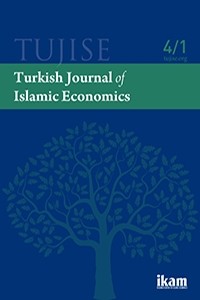RİBA (FAİZ); FİNANSAL İŞLEMLERDEN ÇIKARILMASI GEREKEN BİR ARAÇ
Özellikle Batı ekonomilerinde olmak üzere pek çok ekonominin geleneksel finansal sisteminde faiz ana sürükleyici kuvvettir ve bu durum çift finansal sistemi uygulayan ülkelerde bile geçerlidir. Bu makale, faizi ve onun neden finansal sistemden çıkarılması gerektiğini incelemektedir. Hiçbir dinin hangi biçimde olursa olsun faizin tüketilmesine izin vermediği, sürekli faiz tüketiminin dünya ekonomilerini fakirleştireceği ve artan fayda sağlamadığından dolayı vatandaşların refahını azaltacağı sonucuna varılmıştır. Anahtar Kelimeler: riba (faiz), borç faizi, ticaret faizi, dâhili fayda, indirim oranı
Anahtar Kelimeler:
riba (faiz), borç faizi, ticaret faizi, dâhili fayda, indirim oranı
RIBA (USURY); A TOOL THAT SHOULD BE CARVED OUT OF FINANCIAL TRANSACTIONS
Riba has been major driving force surrounding the conventional financial system of most economies especially the western economies and even economies that practice dual financial system are still not left out. This study seeks to examine riba and why it should be carved out of financial transactions. The study reveals that the no religion permits the consumption of riba in whatever form and concluded that the continuous consumption of riba will impoverish the economies of the world and even the welfare of citizens will not be left out because it is a tool that does not work in increasing utility.Keywords: riba (usury), fiqh riba al-duyun (debt usury), riba-al-buyu" (trade usury), intrinsic utility, discount rate
___
- Abdulrahaman, Y (2010). The Art of Islamic Banking and Finance; Tools and Techniques for Community based banking. New Jersey. John Wiley and Sons. Pp 16- 41
- Ahmad, S.A. (1958) Economics of Islam (A Comparative Study), Lahore, India: Sh. Muhammad Ashraf.p. 36
- Ali Y. A (1989): The Holy Quran. Maryland. Amana Corporation. 4th Edition
- Al-Musnad A. M (2002). Islamic Fatawah (Islamic Verdicts). Vol 3 “Mosque, Funerals,Zakah, Fasting and Sales transaction”. Riyadh. Darusalam.Pp.348- 352
- Arif,M, Hussaini, A, Azzem,M (2012).”Riba Free Economy Model” International Journal of Humanities and Social Sciences. 2(6). P.141
- Bagsiraj M. I (2009), “ Financial and Economic Crisis An Alternative Indian Approach”, Radiance Viewsweekly, Vol XLVI No. 38, 2009-01-04. Available at http://www.radianceweekly.com/137/3037/GLOBAL-MELTDOWN-its-Viable-Alternative/2008-12-14/Cover-story/Story-Detail/Current-Financial-Crisis-and-Islamic-Economics.html. Retrieved on February 3,2016. 08:48am
- Chapra, M. U (2009), “Global Islamic Financial Crisis, Can Islamic Finance Help?”, New Horizon, January-March, 2009, Issue No.170. http://www.newhorizonislamicbanking.com/index.cfm?section=archive=view&id=81. Retrieved on February 03,2016. 08:49am
- Doi A (2007). Shariah: The Islamic Law. Malaysia. As-Noordeen Press. 7th Edition. Pp. 375-380
- Hassan, A (2009). “The Global Financial Crisis and Islamic Banking” In
- www.islamic-foundation.org.uk. Retrieved August 28, 2015. 3:20pm
- Kennedy, M. (1995) Interest and Inflation Free Money, Okemos: Seva International.
- Keynes, J.M. (1936) A General Theory of Employment, Interest and Money, London: MacMillan & Co.p. 350
- Lipsey, R.G and Chrystal, K.A (1995), An Introduction to Positive Economics. 8th Edition, Oxford University Press.
- Rahman,F (1964)” Riba and Interest; Islamic Studies (Karachi) 3(1). P.1-43
- Gait. A. H and Worthington A.C (2007).” A Primer on Islamic Finance: Definations, Sources, Principles and Methods” University of Wollongong, School of Accounting and Finance working paper series No. 07/05, Pp. 1-26
- http://en.m.wikipedia.org/wiki/ethic_of_reciprocity. Retrieved 23/07/2015. 8:37am
- Muslehuddin, M (2008). Banking and Islamic Law. New Delhi: Adam Publishers and Distributors. Pp. 82-87
- Moore, P (1997). Islamic Finance: A Partnership for Growth. Euromoney. London
- Pearce, D.W. and Turner, R.K. (1990) Economics of Natural Resources and the Environment, London: Harvester Wheatsheaf
- Siddiqi, M (2004). Riba, Bank Interest and the Rationale of its prohibition. Islamic Research and Training Institute, Islamic Development bank, Jeddah
- Siddiqi, M. N (2009), “ Current Financial Crisis and Islamic Economics”, Radiance Viewsweekly, Vol XLVI No. 38, 2009-01-04. Available at http://www.radianceweekly.com/137/3037/GLOBAL-MELTDOWN-its-Viable-Alternative/2008-12-14/Cover-story/Story-Detail/Current-Financial-Crisis-and-Islamic-Economics.html. Retrieved on February 3,2016. 08:48am
- Tanko Y (2005). Islamic Banking Interest Free. Kano.Pp. 6-18
- Vetican Newspaper (2009). Osservatore Romano. “Islamic Banking May
- Help Overcome Crisis”, In www.bloomberg.com/app/new?pid=newsarchier&sid=a0soLE8uiN0g
- Visser, A.M. and McIntosh, A (1998)” Historical Critiqueof Usury” Accounting, Business & Financial History, 8:2, Routledge, London, Pp. 175-189. In http://www.lariba.com/Financing/HistoricalCritqueUsury.shtm. Retrieved on 25/10/2013. 4:50pm
- Warde I (2000). Islamic Finance in Global Economy. Edinburgh.Edinburgh University press. Pp 1- 180
- Yahya A and Alazeez (2002): “Section of Prohibition of Usury” Riyaad-Us- Saliheen (Gardens of the Virtuous people). Egypt. Dar Al-Ghadd Al Gaddeed. P.939
- Başlangıç: 2014
- Yayıncı: Research Center for Islamic Economics (ikam)
Sayıdaki Diğer Makaleler
RİBA (FAİZ); FİNANSAL İŞLEMLERDEN ÇIKARILMASI GEREKEN BİR ARAÇ
SUKUK FİNANSMANI İKTİSADİ BÜYÜMEYİ TEŞVİK EDER Mİ? SUKUK ÇIKARAN ANA ÜLKELER ÜZERİNE BİR ÇALIŞMA
Abdelghani ECHCHABI, Hassanuddeen ABD.AZIZ, Umar IDRISS
HURŞİD AHMET’İN İKTİSAT DÜŞÜNCESİ
İSLAM HUKUKUNDA HAYAT SİGORTASINA YENİDEN BAKIŞ
PİYASALARIN AYRIŞMASI VE MALİ İSTİKRARSIZLIK: KLASİK DİKOTOMİYE YAKIN BİR BAKIŞ
